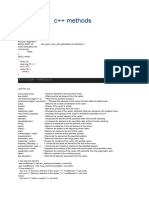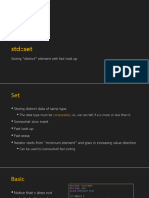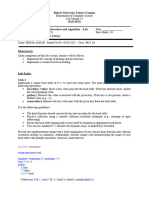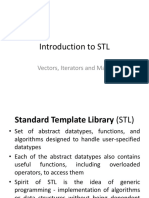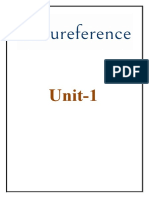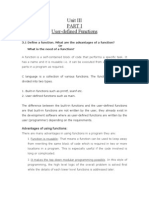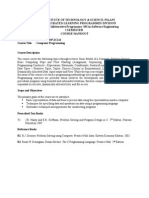Hashmaps
Introduction to hashmaps
Suppose we are given a string or a character array and asked to find the maximum
occurring character. It could be quickly done using arrays. We can simply create an
array of size 256, initialize this array to zero, and then, simply traverse the array to
increase the count of each character against its ASCII value in the frequency array.
In this way, we will be able to figure out the maximum occurring character in the
given string.
The above method will work fine for all the 256 characters whose ASCII values are
known. But what if we want to store the maximum frequency string out of a given
array of strings? It can’t be done using a simple frequency array, as the strings do
not possess any specific identification value like the ASCII values. For this, we will be
using a different data structure called hashmaps.
In hashmaps, the data is stored in the form of keys against which some value is
assigned. Keys and values don’t need to be of the same data type.
If we consider the above example in which we were trying to find the maximum
occurring string, using hashmaps, the individual strings will be regarded as keys,
and the value stored against them will be considered as their respective frequency.
For example: The given string array is:
str[] = {“abc”, “def”, “ab”, “abc”, “def”, “abc”}
Hashmap will look like as follows:
1
�
Key (datatype Value
= string) (datatype =
int)
“abc” 3
“def” 2
“ab” 1
From here, we can directly check for the frequency of each string and hence figure
out the most frequent string among them all.
Note: O
ne more limitation of arrays is that the indices could only be whole numbers but
this limitation does not hold for hashmaps.
The values are stored corresponding to their respective keys and can be invoked
using these keys. To insert, we can do the following:
● hashmap[key] = value
● hashmap.insert(key, value)
The functions that are required for the hashmaps are(using templates):
● insert(k key, v value): To insert the value of type v against the key of type k.
● getValue(k key): T
o get the value stored against the key of type k.
● deleteKey(k key): To delete the key of type k, and hence the value
corresponding to it.
To implement the hashmaps, we can use the following data structures:
1. Linked Lists: To perform insertion, deletion, and search operations in the
linked list, the time complexity will be O(n) for each as:
○ For insertion, we will first have to check if the key already exists or not,
if it exists, then we just have to update the value stored corresponding
to that key.
2
�
○ For search and deletion, we will be traversing the length of the linked
list.
2. BST: We will be using some kind of a balanced BST so that the height remains
of the order O(logN). For using a BST, we will need some sort of comparison
between the keys. In the case of strings, we can do the same. Hence,
insertion, search, and deletion operations are directly proportional to the
height of the BST. Thus the time complexity reduces to O(logN) for each.
3. Hash table: U
sing a hash table, the time complexity of insertion, deletion,
and search operations, could be improved to O(1) (same as that of arrays).
We will study this in further sections.
Inbuilt Hashmap
In the STL, we have two types of hashmaps:
● map (uses BST implementation)
● unordered_map (uses hash table implementation)
Note: B
oth have similar functions and similar ways to use, differing only in the time
complexities. The time complexity of each of the operations(insertion, deletion, and
searching) in the m
ap i s O(logN), while in the case of unordered_map, they are
O(1).
unordered_map:
● Header file: #include<unordered_map>
● Syntax to declare:
unordered_map<datatype_for_keys, datatype_for_values> name;
● Operations performed:
1. Insertion: Suppose, we want to insert the string “abc” with the value 1
in the hashmap named ourmap, there are two ways to do so:
3
�
■ Simply create a pair of both and insert in the map using .insert
function. Syntax:
pair<string, int> p = {“abc”, 1};
ourmap.insert(p);
■ An easier way to insert in a map is to insert like arrays. Syntax:
ourmap[“abc”] = 1;
2. Searching: S
uppose we want to find the value stored in the hashmap
against key “abc”, there are two ways to do so:
○ As did in insertion like arrays, the same way we can figure out
the value stored against the corresponding key. Syntax:
int value = ourmap[“abc”];
○ Using .at() function. Syntax:
int value = ourmap.at(“abc”);
Note: I f we try to access a key that is not present in the unordered_map, then there
are two different outcomes:
➢ If we are accessing the value using .at() function, then we will get an error
specifying that we are trying to access the value that is not present in the
map.
➢ On the other hand, if we access the same using square brackets, then by
default, a new key will be created with the default value to be 0 against it.
This approach will not give any error.
But what if we want to check if the key is present or not on the map? For that, we
will be using the .count() function, which tells if the key is present in the map or not.
It returns 0, if not present, and 1, if present
Syntax:
4
�
int isPresent = ourmap.count(“ghi”); / / isPresent could only be 0 or 1
Note: W
e can also check the size of the map by using .size() function, which returns the
number of key-value pairs present on the map.
Syntax:
int size_of_map = ourmap.size();
3. Deletion: Suppose we want to delete the key “ abc” f rom the map,
we will be using .erase() function.
Syntax:
ourmap.erase(“abc”);
Remove Duplicates
Problem statement: G
iven an array of integers, we need to remove the duplicate
values from that array, and the values should be in the same order as present in
the array.
For example: Suppose the given array is arr = {1, 3, 6, 2, 4, 1, 4, 2, 3, 2, 4, 6}, answer
should be {1, 3, 6, 2, 4}.
Approach: We will add unique values to the vector and then return it. To check for
unique values, start traversing the array, and for each array element, check if the
value is already present in the map or not. If not, then we will insert that value in
the vector and update the map; otherwise, we will proceed to the next index of the
array without making any changes.
Let’s look at the code for better understanding.
5
�
vector<int> removeDuplicates(int* a, int size) {
vector<int> output; // to store the unique elements.
unordered_map<int, bool> seen; / / unordered map created
for (int i = 0; i < size; i++) { // traversing the array
if (seen.count(a[i]) > 0) { // using .count() function to check if
continue; // the value has already occurred.
}
seen[a[i]] = true; // If not, then updating the map
output.push_back(a[i]); / / and inserting that value in the vector
}
return output;
}
Iterators
To iterate over STL containers, we can use iterators. These are independent of the
way the data is stored in the container. It just iterates over the desired and returns
all the elements one-by-one. For example, consider the following piece of code:
unordered_map<string, int> ourmap;
ourmap["abc"] = 1;
ourmap["abc1"] = 2;
ourmap["abc2"] = 3;
ourmap["abc3"] = 4;
ourmap["abc4"] = 5;
ourmap["abc5"] = 6;
Now, we want to iterate the above unordered_map. It can be achieved using
iterators.
Steps to use iterators:
1. Declare the iterator of type unordered_map with the same set of data types
as that of key-value pairs and point it to the beginning of the map.
unordered_map<string, int>::iterator it = ourmap.begin();
Note: ourmap.begin() represents the starting position of the map, which could be any
key in case of unordered_map as there is no specific order of data inserted in it.
6
�
Although, we will be able to cover entire map elements using iterators irrespective of the
position that ourmap.begin() points to.
2. Now, simply put the iterator value in the loop until it reaches the end.
while (it != ourmap.end()) {
cout << "Key : " << it->first << " Value: " << it->second << endl;
it++; // increasing the iterator so that it points to next value
}
// Here, it->first points to the key and it->second points to the value
// corresponding to it.
Similarly, iterators can also be used on the vectors. Since vectors have a specific
order of the elements stored in it, so .begin() will always point to the first position of
the vector, i.e., the zeroth index. Refer to the code below for a better explanation.
vector<int> v;
v.push_back(1);
v.push_back(2);
v.push_back(3);
v.push_back(4);
v.push_back(5);
// iterator declared and pointed to the first position
vector<int>::iterator it1 = v.begin();
// Now, using the while() loop to reach every element of the vector
while (it1 != v.end()) {
cout << *it1 << endl; // *it1 prints the value pointed by itertor it1
it1++; // Incrementing the value of iterator so that
//it points to the further indexes
}
Note: U
sing .find() on map, it returns an iterator to that position. To erase the
element from the map, we can directly provide that iterator to the .erase() function.
Refer to the code below:
unordered_map<string, int>::iterator it2 = ourmap.find("abc");
ourmap.erase(it2);
7
�
Bucket array and hash function
Now, let’s see how to perform insertion, deletion, and search operations using hash
tables. Till now, we have seen that arrays are the fastest way to extract data as
compared to other data structures as the time complexity of accessing the data in
the array is O(1). So we will try to use them in implementing the hashmaps.
Now, we want to store the key-value pairs in an array, named as a b
ucket array.
We need an integer corresponding to the key so that we can keep it in the bucket
array. To do so, we use a h
ash function. A hash function converts the key into an
integer, which acts as the index for storing the key in the array.
For example: Suppose, we want to store some names from the contact list in the
hash table, check out the following the image:
8
�
Suppose we want to store a string in a hash table, and after passing the string
through the hash function, the integer we obtain is equal to 10593, but the bucket
array’s size is only 20. So, we can’t store that string in the array as 10593, as this
index does not exist in the array of size 20.
To overcome this problem, we will divide the hashmap into two parts:
● Hash code
● Compression function
The first step to store a value into the bucket array is to convert the key into an
integer (this could be any integer irrespective of the size of the bucket array). This
part is achieved by using hashcode. For different types of keys, we will be having
different kinds of hash codes. Now we will pass this value through the compression
function, which will convert that value within the range of our bucket array’s size.
Now, we can directly store that key against the index obtained after passing
through the compression function.
The compression function can be used as (% bucket_size).
One example of a hash code could be: (Example input: “abcd”)
“abcd” = (‘a’ * p3) + (‘b’ * p2) + (‘c’ * p1) + (‘d’ * p0)
Where p is generally taken as a prime number so that they are well
distributed.
But, there is still a possibility that after passing the key through from hash code,
when we give the same through the compression function, we can get the same
values of indices. For example, let s1 = “ab” and s2 = “cd”. Now using the above hash
function for p = 2, h1 = 292 and h2 = 298. Let the bucket size be equal to 2. Now, if
we pass the hash codes through the compression function, we will get:
9
�
Compression_function1 = 292 % 2 = 0
Compression_function2 = 298 % 2 = 0
This means they both lead to the same index 0.
This is known as a collision.
Collision Handling
We can handle collisions in two ways:
● Closed hashing (or closed addressing)
● Open addressing
In closed hashing, each entry of the array will be a linked list. This means it should
be able to store every value that corresponds to this index. The array position holds
the address to the head of the linked list, and we can traverse the linked list by
using the head pointer for the same and add the new element at the end of that
linked list. This is also known as separate chaining.
On the other hand, in open addressing, we will check for the index in the bucket
array if it is empty or not. If it is empty, then we will directly insert the key-value pair
over that index. If not, then will we find an alternate position for the same. To find
the alternate position, we can use the following:
hi(a) = hf(a) + f(i)
Where hf(a) is the original hash function, and f(i) is the i-th try over the hash
function to obtain the final position hi(a).
To figure out this f(i), following are some of the techniques:
1. Linear probing: In this method, we will linearly probe to the next slot until
we find the empty index. Here, f(i) = i.
10
�
2. Quadratic probing: A
s the name suggests, we will look for alternate i2
positions ahead of the filled ones, i.e., f(i) = i2.
3. Double hashing: A
ccording to this method, f(i) = i * H(a), where H(a) is some
other hash function.
In practice, we generally prefer to use separate chaining over open addressing, as it
is easier to implement and is also more efficient.
Let’s now implement the hashmap of our own.
Hashmap implementation - Insert
As discussed earlier, we will be implementing separate chaining. We will be using
value as a template and key as a string as we are required to find the hash code for
the key. Taking key as a template will make it difficult to convert it using hash code.
Let’s look at the code for the same.
#include <string>
using namespace std;
template <typename V>
class MapNode { // class for linked list.
public:
string key; // to store key of type string
V value; // to store value of type template
MapNode* next; // to store the next pointer
MapNode(string key, V value) { // constructor to assign values
this->key = key;
this->value = value;
next = NULL;
}
~MapNode() { / / Destructor to delete the node.
delete next;
}
};
template <typename V>
class ourmap { // for storing the bucket array
11
�
MapNode<V>** buckets; // a 2D bucket array to store the head pointers
// of the linked list corresponding to each index.
int count; // to store the size
int numBuckets; / / to store number of buckets for compression function
public:
ourmap() { / / constructor: to initialize the values
count = 0; //
numBuckets = 5;
buckets = new MapNode<V>*[numBuckets]; // dynamically allocated
for (int i = 0; i < numBuckets; i++) {
buckets[i] = NULL; // assigning each head pointer to NULL
}
}
~ourmap() { / / destructor: to delete the storage used
for (int i = 0; i < numBuckets; i++) { / / first-of-all delete each linked list
delete buckets[i];
}
delete [] buckets; / / the delete the total bucket
}
int size() { / / to return the size of the map
return count;
}
V getValue(string key) {// for returning the value corresponding to a key
// will see in the next section
}
private:
int getBucketIndex(string key) { / / to provide the index using hash function
int hashCode = 0;
int currentCoeff = 1;
// using “abcd” = (‘a’ * p3) + (‘b’ * p2) + (‘c’ * p1) + (‘d’ * p0) as our hash code
for (int i = key.length() - 1; i >= 0; i--) {
hashCode += key[i] * currentCoeff;
hashCode = hashCode % numBuckets;
currentCoeff *= 37; / / taking p = 37
currentCoeff = currentCoeff % numBuckets;
}
return hashCode % numBuckets;
}
public:
void insert(string key, V value) {
12
�
// To get the bucket index, i.e., passing it through the hash function
int bucketIndex = getBucketIndex(key);
// to insert the key-value pair in the linked list corresponding to index obtained
MapNode<V>* head = buckets[bucketIndex];
while (head != NULL) {
if (head->key == key) { // If key already present, then we are
head->value = value; // just updating the value against it
return;
}
head = head->next;
}
// otherwise creating a new node and inserting that node before head so making it
// as the head and marking the bucket index to this node as the new head
head = buckets[bucketIndex];
MapNode<V>* node = new MapNode<V>(key, value);
node->next = head;
buckets[bucketIndex] = node;
count++;
}
};
Hashmap implementation - Delete and search
Refer to the code below and follow the comments in it.
// to search for the key
V getValue(string key) {
int bucketIndex = getBucketIndex(key); // find the index
MapNode<V>* head = buckets[bucketIndex]; // head of linked list
while (head != NULL) {
if (head->key == key) { // if found, returned the value
return head->value;
}
head = head->next;
}
return 0; / / if not found, returning 0 as default value.
}
// to delete the key-value pair
V remove(string key) {
int bucketIndex = getBucketIndex(key); // find the index
MapNode<V>* head = buckets[bucketIndex]; // head node
MapNode<V>* prev = NULL; // previous pointer
while (head != NULL) {
13
�
if (head->key == key) {
if (prev == NULL) {
buckets[bucketIndex] = head->next;
} else {
prev->next = head->next; / / connecting previous
// to the head’s next pointer
}
V value = head->value;
head->next = NULL; / / before calling delete over it, in
// order to avoid complete linked list deletion, we have to assign it’s next to NULL
delete head;
count--; / / reducing the size
return value;// return the value stored at deleted node
}
prev = head;
head = head->next;
}
return 0; / / means that value not found
}
Time Complexity and Load Factor
Let’s define specific terms before moving forward:
1. n = Number of entries in our map.
2. l = length of the word (in case of strings)
3. b = number of buckets. On average, each box contains (n/b) entries. This is
known as load factor means b boxes contain n entries. We also need to
ensure that the load factor is always less than 0.7, i.e.,
(n/b) < 0.7, this will ensure that each bucket does not contain too
many entries in it.
4. To make sure that load factor < 0.7, we can’t reduce the number of entries,
but we can increase the bucket size comparatively to maintain the ratio. This
process is known as R
ehashing.
14
�
This ensures that time complexity is on an average O(1) for insertion, deletion, and
search operations each.
Rehashing
Now, we will try to implement the rehashing in our map. After inserting each
element into the map, we will check the load factor. If the load factor’s value is
greater than 0.7, then we will rehash.
Refer to the code below for better understanding.
void rehash() {
MapNode<V>** temp = buckets; // To store the old bucket
buckets = new MapNode<V>*[2 * numBuckets]; // doubling the size
for (int i = 0; i < 2*numBuckets; i++) {
buckets[i] = NULL; // initialising each head pointer to NULL
}
int oldBucketCount = numBuckets;
numBuckets *= 2; / / updating new size
count = 0;
for (int i = 0; i < oldBucketCount; i++) {
MapNode<V>* head = temp[i];
while (head != NULL) {
string key = head->key;
V value = head->value;
insert(key, value); / / inserting each value of old bucket
// into the new one
head = head->next;
}
}
// deleting the old bucket
for (int i = 0; i < oldBucketCount; i++) {
MapNode<V>* head = temp[i];
delete head;
}
delete [] temp;
}
void insert(string key, V value) {
int bucketIndex = getBucketIndex(key);
MapNode<V>* head = buckets[bucketIndex];
while (head != NULL) {
if (head->key == key) {
head->value = value;
15
�
return;
}
head = head->next;
}
head = buckets[bucketIndex];
MapNode<V>* node = new MapNode<V>(key, value);
node->next = head;
buckets[bucketIndex] = node;
count++;
// Now we will check the load factor after insertion.
double loadFactor = (1.0 * count)/numBuckets;
if (loadFactor > 0.7) {
rehash(); / / We will rehash.
}
}
Note: W
hile solving the problems, we will be using the in-built hashmap only.
Practice problems:
● https://www.codechef.com/problems/STEM
● https://codeforces.com/problemset/problem/525/A
● https://www.spoj.com/problems/ADACLEAN/
16






















